Reports
Breaking Up and Reorienting Iran’s Nuclear Weapons Program - Iran’s Nuclear Archive Shows the 2003 Restructuring of its Nuclear Weapons Program, then called the AMAD Program, into Covert and Overt Parts
by David Albright, Olli Heinonen,[1] and Andrea Stricker
October 29, 2018
For a summary of this report, click here.
New documentation seized by Israel from the Iranian “Nuclear Archive”2 shows that in mid-2003, Iran was making decisions about how to decentralize and disperse the elements of its nuclear weaponization program, the AMAD program and its subsidiary Project 110, which included nuclear warhead development. The archive3 shows that the AMAD program intended to build five nuclear warhead systems for missile delivery and possible use in preparation for an underground nuclear test;4 an actual test would require a decision to proceed. The program was also partially designed to have its own independent uranium mining, conversion, and enrichment resources. The documentation indicates that Iran’s nuclear weaponization efforts did not stop after 2003, following a so-called “halt order.”
To conduct this assessment of the evolution of Iran’s nuclear weapons program, the Institute obtained vital archive documentation from the media and during interviews with senior Israeli intelligence officials familiar with the archive. In this report, we assess and compare new information with other public documents and information. The archive documentation shows that rather than halting its nuclear weaponization work, Iran was carrying out an elaborate effort to break the AMAD program into covert and overt parts, where the overt parts would be centered at research institutes and universities, and any effort that could not be plausibly denied as civilian in nature was left as a covert activity. The weaponization program carried on in a more research-oriented fashion after 2003, aimed at eliminating scientific and engineering bottlenecks in developing nuclear weapons, increasing know-how about them, and maintaining valuable expertise. A key criterion for whether a program could be considered covert or overt was whether it involved handling of nuclear material leaving traces of radioactive contamination, presumably that which could be detected by international nuclear inspectors or foreign intelligence services. In addition, work was judged on whether it could be explained as a peaceful application, e.g. it allowed Iran to disguise a nuclear weapons effort as a carefully sculpted civilian nuclear activity or non-nuclear military activity. Iran also focused on the portability of sensitive work, or ease of moving it quickly if needed. The most recent name of the nuclear weapons program that evolved from the AMAD program is known by the acronym SPND (Sazman-e Pazhouhesh-haye Novin-e Defa’ei), or Organization of Defensive Innovation and Research, in English, according to Israel and reports by the International Atomic Energy Agency (IAEA).
The United States incorrectly assessed with high confidence in a 2007 declassified National Intelligence Estimate (NIE) that “in fall 2003, Tehran halted its nuclear weapons program.”5 Based on the information in the archives, Iran’s nuclear weapons program continued after 2003 in this more limited, dispersed fashion. Moreover, the 2007 NIE also incorrectly asserted that Iran had not re-started its nuclear weapons program as of mid-2007, albeit with only moderate confidence.6 It should be noted that the term “moderate confidence” demonstrates the limitations of intelligence information. However, there is no evidence that the program was ever fully halted, even up to today.
The information in the archive evaluated so far does not answer the question of what the current status of Iran’s nuclear weapons program is. The archive’s existence and its careful maintenance strongly support that Iran at least wants to remain ready to build nuclear weapons, despite the Joint Comprehensive Plan of Action (JCPOA). It is sobering that the question of whether Iran’s nuclear weapons program was truly halted was not settled by the time the JCPOA was implemented in early 2016. At the time, most deal advocates argued that the “absence of evidence is evidence of absence,” or even that intelligence communities had a sound enough understanding of how far Iran had gone in nuclear weapons development, so it did not matter that a full IAEA accounting and investigation would not be done. This was a mistake, as the archives are now revealing – the United States overstated the fulsomeness of what it knew at the time of the conclusion of the JCPOA. Today, there is only partial implementation of the key verification arrangements in the JCPOA aimed at limiting Iran’s nuclear weapons work, and progress on this issue is expected to remain slow at best. Moreover, the IAEA, under its safeguards agreement with Iran, has remained, inter alia, due to the lack of support from the P5+1 and its own governing bodies, unable to access relevant military sites or personnel associated with potential on-going or past nuclear weapons work. Almost three years after the implementation of the JCPOA, and with its fate at issue, there is insufficient information to settle the question of the status of Iran’s on-going work on nuclear weapons. This together with the sunset provisions in the JCPOA, and lack of any credible verification of the status and monitoring of its ballistic and cruise missile program, have kept open a pathway for Iran’s nuclear weapons capability.
Background
Iran was operating a sophisticated, well-structured nuclear weapons program in 2003, when the IAEA, backed by Western governments, started to uncover secret Iranian nuclear facilities and activities, including Iran’s violations under its safeguards agreement concluded pursuant its obligations under the Nuclear Non-Proliferation Treaty (NPT). However, the IAEA investigations had not fully uncovered the secret work to make a nuclear weapon, having much more success exposing Iran’s clandestine efforts to enrich uranium and produce plutonium. Fearful of U.S. military strikes following the U.S.-led invasion of Iraq, and confronted with revelations about its wholesale deception and concealment related to its IAEA safeguards commitments and intense international condemnation, the Iranian regime decided to become significantly more open about its principal fuel cycle activities. These were being systematically exposed by the IAEA anyway. Iran decided to reduce and hide more thoroughly its structured nuclear weapons efforts aimed at the development of a nuclear warhead. At the time of this decision, current Iranian president Hassan Rouhani was the national security advisor to Supreme Leader Ayatollah Khamenei and the public face of Iran’s new “openness” to the IAEA about its formerly secret fuel cycle activities.7 Yet, the nuclear weapons program was carefully hidden and restructured for the future. Iran subsequently launched an international campaign, which duped several U.S. analysts and members of the media, to deny that it ever had a nuclear weapons program, a subterfuge it has maintained until today.
Western governments knew considerable information about Iran’s nuclear weapons program at the time of Iran’s 2003 decision, but they were unable to agree on whether nuclear weapons work continued afterward. The United States ultimately thought it did not; Britain, France, Germany, and Israel believed it continued, albeit at a reduced scale. The IAEA noted in its December 2015 report, “Final Assessment on Past and Present Outstanding Issues Regarding Iran’s Nuclear Programme,” that some of the work continued after 2004, but it had not found information on work occurring after 2009.8 The archive documentation shows that the Europeans and Israel were correct; the program continued after 2003. This trove contains vital information about Iran’s past nuclear weapons-related efforts under the AMAD Plan, which was most active in 2002 and 2003.
The tranche also contains new information about the restructuring of the AMAD program during the summer of 2003, including Project 110, which had developed nuclear warhead designs and was actively developing slightly different warhead designs as its work progressed. The Institute collected other Iranian documents,9 presentations by Israeli officials to the media, and additional information from Israeli officials who have studied the archive, that show that despite the apparent halt, the AMAD program carried on. Certain documents focus on “Project 110,” or activities which relate to nuclear warhead development. Project 110’s work was being divided into two parts: a covert part with a secret structure and goals whose activities had no ostensible civilian cover story, and an overt, research-oriented program centered at universities whose activities had plausible civilian applications.
New Revelations
Project 110’s work focused principally on developing, manufacturing, and eventually testing the nuclear warhead. The IAEA referred to Project 110 in its 2011 Iran safeguards reporting as covering “payload design.”10 Project 110 contained programs at the core of Iran’s nuclear weapons effort, and its continuation, albeit at a reduced level, undermines any claim that Iran’s nuclear program became purely peaceful. The findings from the nuclear archive, and still to be investigated nuclear warehouse,11 tend to support that Iran is maintaining substantive information, capabilities, and expertise related to nuclear weapon development. While the JCPOA attempts to contain for a limited time Iran’s uranium enrichment activity, it left aside the matter of ballistic and cruise missile development which is key to nuclear warhead delivery, and monitors possible nuclear weaponization efforts in a limited way. Before the IAEA can conclude that Iran’s nuclear program is peaceful, for example, these deficiencies must be addressed.
The archive documentation shows that in mid-2003, Iran began holding meetings to make decisions about how to decentralize and disperse the elements of the AMAD program and its Project 110. Slides provided by Israel and source documents in Farsi narrate how Iran held a series of “intensive meetings” under a “Project 110 technical committee” in August and September 2003, “following new instructions by the Minister of Defense…in order to accommodate the activities to the instructions.”12 These meetings were held at the height of the IAEA’s confrontation with Iran over a hidden gas centrifuge program and happened soon after Baghdad had fallen to U.S. troops. It is also important to note that at this stage, in about September 2003, the E3’s foreign ministers (France, Britain, and Germany) engaged with Iran and requested a full and complete declaration on its current and past nuclear program, and adherence to the Additional Protocol of the IAEA.
Figures 1 and 2 are meeting dates and quotes from minutes from documents in the nuclear archive for the Project 110 technical committee tasked with dispersing the AMAD Plan’s Project 110 elements. The documents show that eight meetings occurred during August and September 2003, in preparation for the so-called “halt order,” and at a time when the IAEA was asking to go to additional, suspect Iranian nuclear sites including military ones (Figure 1). Highlights of the minutes of the meetings appear to show the thoughts of the participants on how the overt and covert activities should be divided (Figure 2).
Dr. Fereidoun Abbasi-Davani urged, “We should make a distinction between ‘overt’ and ‘covert’ activities.” Abbasi-Davani was responsible, along with Majid Shariari, for deploying a specially developed neutron detector array outside of the high explosive chamber in Taleghan 1 at the Parchin site.13 It measured the neutron emissions from a neutron initiator for a nuclear weapon made from uranium and deuterium. Shariari was killed in an assassination in October 2010, and Abbasi-Davani barely survived an attempt that same day. Later, in February 2011, Abbasi-Davani became the head of the Atomic Energy Organization of Iran (AEOI), a position he held until August 2013.
A Dr. Majid (unknown if Majid Shariari) stated, “Overt activities are those that could be explained as part of something else, and not as part of the project, so that we would have an excuse for them.” A Dr. Masoud stated, “’Neutrons’ research could not be considered ‘overt’ and needs to be concealed. We cannot excuse such activities as defensive. Neutron activities are sensitive and we have no explanation for them.” Such work had been happening at the Parchin site in specially constructed high explosive chambers.14 Dr. Mohammed-Mehdi Hadavi (a Ministry of Defense official) noted, “Let there be no mistake, the amount of personnel in the overt and covert parts will not decrease. The structure will not become smaller and every sub-project will supervise both its overt and covert parts.” Dr. Masoud also stated, “Development of methods and facilities could be considered overt – all other explorations should be covert.”
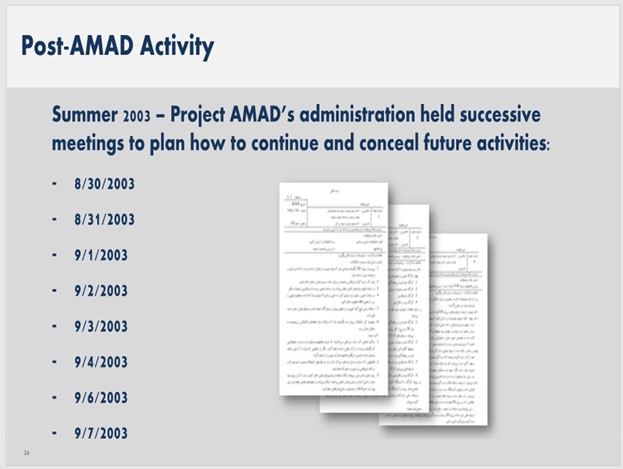
Figure 1. Farsi language documents from the Iranian archive show a series of meetings were held by Iranian officials in August and September 2003 to discuss the dispersal of the covert and overt parts of the AMAD program. The figure comes from a slide deck provided by Israel.
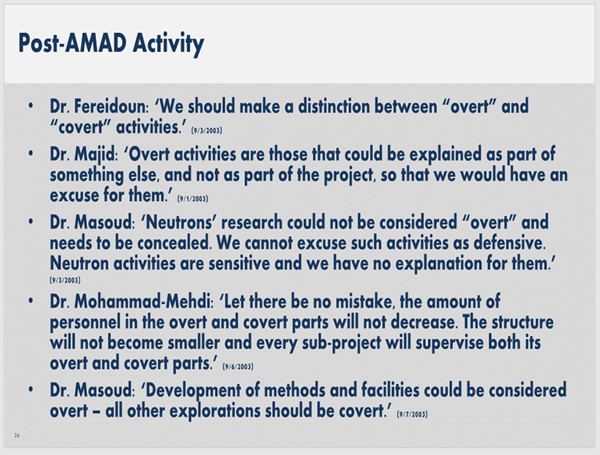
Figure 2. Minutes translated by Israel from the Project 110 technical committee meetings. A copy of the original Farsi document was not provided. The figure comes from a slide deck provided by Israel.
These meetings led to the development of a new organizational structure for the AMAD program. An Iranian document outlines the changes in Project 110 that resulted from these meeting and the Minister of Defense’s new instructions. Figure 3 shows the Iranian document that contains details about the split of Project 110 into overt and covert activities (Figure 4 contains its translation). The document, titled “Re-Planning 110 According to New Instructions,” states, as translated by Israel and verified by the Institute:
In the new outline, the work would be divided in two: covert (secret structure and goals) and overt (regular structure). The covert operations are directed towards the completion of the existing timetable of building nuclear weapons. In order to do so, the operations were divided into two types of work: contaminating and non-contaminating work.
The contaminating work would occur “after the non-contaminating work.” The timetable for the work mentioned in the document is not known, but it signifies nonetheless that the goal of the new organization was to finish building nuclear weapons.
A fundamental criterion for whether Project 110 work would be put into a covert or overt category was whether it involved “contaminating” work, which could leave “identifiable traces.” At the time, the Iranian officials would have been well aware of the power of the IAEA’s environmental sampling to detect minute traces of nuclear materials at its secret fuel cycle facilities. Moreover, “the members’ attention will be focused on the portability, in order for us to stay clear both of espionage and to leave no identifiable traces.” The portability was ostensibly for the ease of moving the work quickly, if needed, in order to avoid detection (Figures 3 and 4). These are the lessons Iran learned during the spring of 2003 when the IAEA found highly enriched uranium particles at several locations in Iran after Iran stated that it had not used any nuclear material in its indigenously made centrifuges. Moreover, in some areas, like in the secret centrifuge R&D facility, Kalaye Electric, Iran was only partially successful at covering up suspect areas with layers of tiles and fresh paint. During this confrontation with the IAEA, Iran likely developed the idea of using mobile containers, which could house smaller-scale activities such as the conversion of uranium hexafluoride to uranium metal components or contain diagnostic and other equipment to allow tests of high explosive components.
The overt part of the program would “prepare and develop the foundation; therefore it was planned and proposed to establish two university centers under the names ‘Institute for Applied Physics’ and ‘Center for Shock and Explosion Technology Research.’ Moreover, it is necessary to use the Chemical Engineering and Material Center at the Malek Ashtar University.” The document continued (spelling mistakes corrected), “Both centers mentioned above will not be linked with 110 and will belong administratively to the new institute or the university. However, because of the depth of the coordination, their supervisor needs to be appointed in accordance to 110’s executor.”15 This suggests that the projects would have continuity through their leadership, but plausible deniability as to their connection to Project 110. Several Iranian universities have an Institute for Applied Physics, and the name would provide a good civilian cover for activities sponsored by the successor organization to Project 110 envisioned by the leadership.
The document also discusses three fundamental plans: Sareb 1, 2, and 3 (Figures 3 and 4):
Sareb 1: A system for a static test of the product as a basic plan with an existing specification. This specification will be re-examined and authorized by the project’s technical committee.
The Israeli slide relevant to this translation (Figure 3) views this plan as related to a “device for a nuclear test.” The nuclear archive contained documents related to Iran’s search for and consideration of five candidate nuclear test sites.16 The document discussed here likely indicates that Iran maintained its original plan to be able to conduct an underground nuclear test, although the available documents do not make clear if work continued on finding a suitable test site.
Sareb 2: A system suitable for integrating on the warhead. Its specifications will also be designed to address flight requirements of 111.
“111,” likely Project 111, is referenced in IAEA reports as a project for the integration of a nuclear device on a delivery system. Project 111 was ultimately dispersed to the Center for R&D of Advanced Aeronautical Technologies. The IAEA calls Project 111 that for “studying how to integrate the new payload into the chamber of the Shahab-3 missile re-entry vehicle.”17 The Shahab-3 was Iran’s medium-range nuclear delivery system of choice for a nuclear weapon in the early 2000s, then with a range of about 1,000 kilometers. The Israeli slide relevant to the translation (Figure 3) characterizes this plan, in summary, as one for “device for integration in warhead.” Figure 5 is a schematic from the archive showing a Shahab-3 re-entry vehicle with a “load,” which is likely a nuclear warhead.
However, due to the lack of monitoring, it is not known whether Iran has continued with the development of the missile re-entry vehicle, which would also include work on necessary explosives operation control systems (EOCS), and testing to ensure the survivability of the vehicle upon re-entry. It is also worth noting that Iran has since 2004 developed other ballistic missiles and a cruise missile, which should have adequate payload capacity to carry nuclear warheads.
Sareb 3: A Shebah-3 warhead equipped with Sareb 2.
The Israeli slide relevant to the translation (Figure 3) characterizes this plan simply as
“Shehab-3 nuclear warhead.”
The documents show that Iran went to great lengths, and found great difficulty, in hiding the most sensitive aspects of the program. It often attempted to avoid using explicit language in documents that would reveal the military nature of the continued, ostensibly civilian activities carried on at research centers and universities.
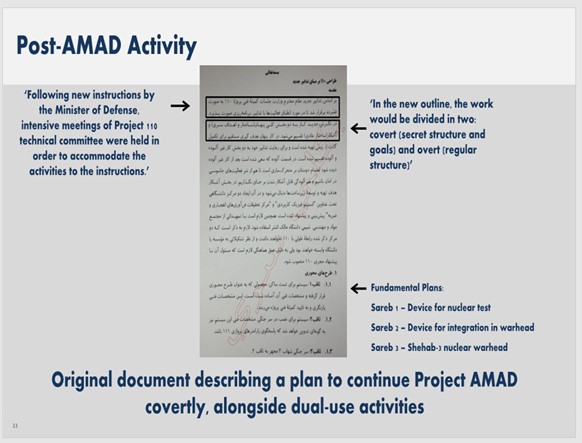
Figure 3. Iranian document seized by Israel from the atomic archive, which outlines plans for the division of Project 110, which includes nuclear warhead development, into covert and overt structures and the fundamental plans of the program. The figure is from a slide deck provided by Israel. See Figure 4 for a translation of the document.
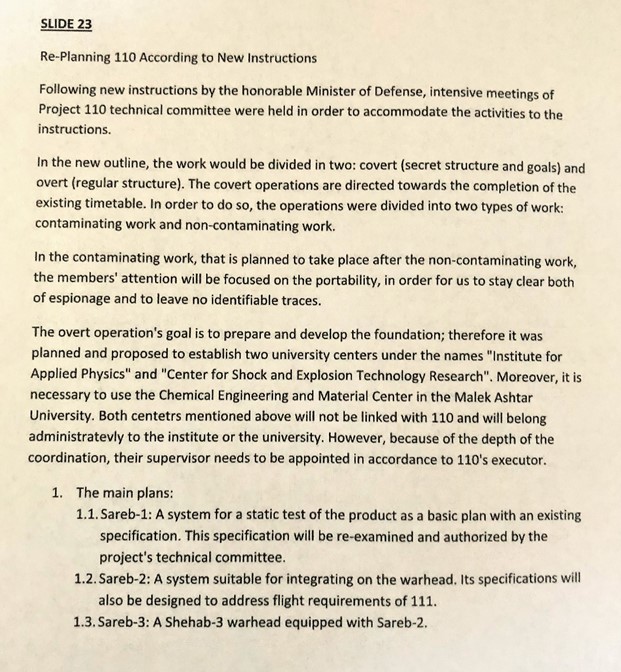
Figure 4. Translation of Farsi document in Figure 3. Source: Israel slide deck, translation independently verified by the Institute.
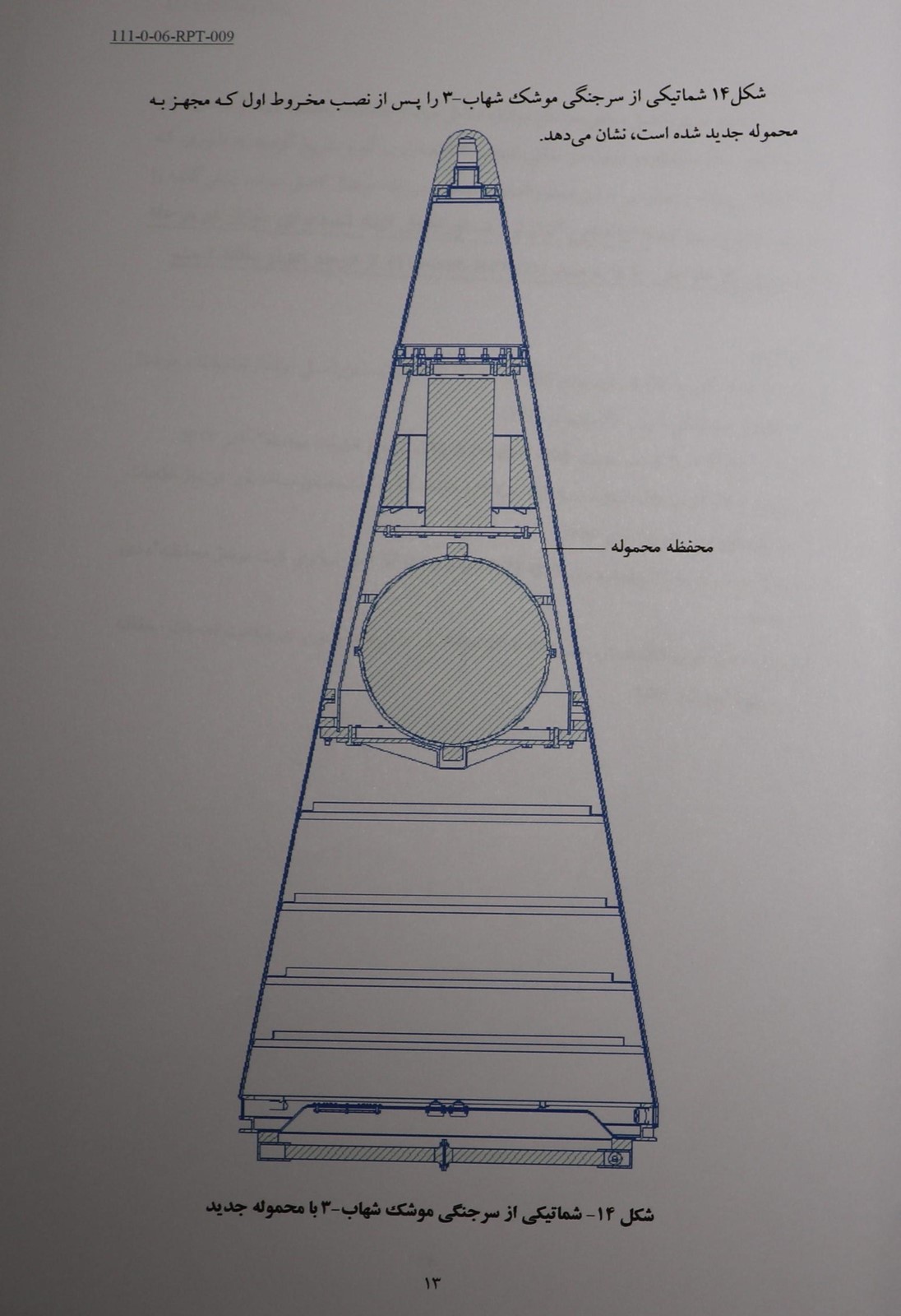
Figure 5. A schematic of a Shahab 3 re-entry vehicle with a “load” inside. The texts in the figure label have been only roughly translated. The top caption is “14 schematic figure shows the Shahab-3 warhead after installing the first cone which is equipped with the new load.” The middle caption points to an inner structure which is labelled the “protector of the load.” The bottom one is “14-schematic image from Shahab-3 warhead with new load.”
The meetings and planning continued. During Prime Minister Netanyahu’s April 2018 presentation about the materials seized from the Iranian archive, he explained another Farsi document dated October 25, 2003 and written by Mohsen Fakhrizadeh, the longtime head of Iran’s nuclear weapons program. Fakhrizadeh stated, “The general aim is to announce the closure of Project Amad…special activities will be carried out under the title of scientific [know-how] development” (Figure 6).
Significantly, Fakhrizadeh’s statement of Iran’s intention to continue nuclear weaponization activities occurred four days after the Iranian Government and the Foreign Ministers of France, Germany and the United Kingdom issued in Tehran an agreed statement on Iran’s nuclear program. In that statement, Iran indicated that it had “decided voluntarily to suspend all uranium enrichment and reprocessing activities as defined by the IAEA.”18 His statement was nine days after National Security Advisor Rouhani told the IAEA that a decision had been taken to provide the IAEA, “in the course of the following week, with a full disclosure of Iran’s past and present nuclear activities. He also expressed Iran’s readiness to conclude an Additional Protocol and, pending its entry into force, to act in accordance with the Protocol and with a policy of full transparency.”19
Yet, Iran’s disclosure turned out to be partial, omitting information about past and on-going nuclear weapons work. Iran also decided, without disclosing to the IAEA, that it would take dramatic steps to hide its past nuclear weapons work at key facilities like the Physics Research Center (PHRC).
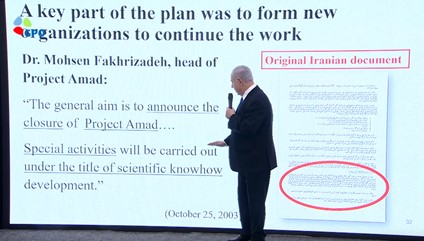
Figure 6. Iranian document from slideshow presentation by Israeli Prime Minister Netanyahu on April 30, 2018.
Destruction of the Physics Research Center
Evidence for the 2003 decision to better hide the nuclear weapons program appeared publicly with the sudden destruction of buildings at the Physics Research Center (PHRC) in north Tehran, which was known to Western intelligence agencies as the center of Iran’s nuclear weapons work in the 1990s. The PHRC was the original incarnation of the covert Iranian nuclear weapons program before it was transformed into the more structured and advanced AMAD program.20 According to the IAEA, the AMAD program was the successor to the PHRC. The IAEA stated, “…By the late 1990s or early 2000s, the PHRC activities were consolidated under the ‘AMAD Plan.’”21
Starting in late 2003 and ending in mid-2004, Iran razed about a half dozen industrial buildings at the PHRC’s main site, in a neighborhood known as Lavizan-Shian, and scraped the ground (see Figure 7).22 Iran then built a sports complex over the razed site. Although the IAEA was eventually allowed access in mid-2004 after the buildings had been razed and the ground scraped, Iran forbade access to any of the building material hauled away that the inspectors wanted to sample for nuclear and other materials. The timing of the razing of the PHRC site corresponds with what the new archive documents show about Iran’s decision making at the time to close down, clean-up, and disperse prior, sensitive work.


Figure 7. Site of the Physics Research Center in Lavizan-Shian and Iran’s razing of the site over several months.
2007 Document by the Neutron Group of the Institute of Physics
An example of the split into overt and covert work discussed above is seen in a planning summary of what is called the “neutron group” reportedly issued in 2007 by the Institute for Physics. This document obtained by the Times of London, and provided to our Institute,23 is titled “Outlook for Special Neutron-Related Activities over the Next 4 Years.” It was written by personnel at the “Centre,” which was stated to be part of the Institute of Physics, and discusses Iran’s four-year plan to continue work that would further the military neutron initiator project at research centers and other locations, and to obtain needed personnel for the project.
It obliquely mentions the restructuring of the program into covert and overt parts and describes how the overt portions would continue to carry out work that could support on a more fundamental basis nuclear weapons-relevant research and experiments (see Figure 8). The document appears to attempt to avoid making obvious the military nature of the projects in its choice of language: “In view of Iran’s situation and considering that the policy adopted by the Centre is to cooperate with research centres and universities in order to carry out its projects, under the Centre’s supervision and control…,” agreements would be “drawn up between the Institute of Physics and the universities and research centres so as to facilitate the above-mentioned projects.” The document also mentions drawing up an agreement for the research with Shaheed Beheshti University (Figure 8).
Types of overt work. Overt work, as referenced in the document, for example, would include designing and performing experiments to detect pulsed neutrons and obtaining some of the neutron detectors and electronic equipment. This work could be done in universities and open research centers.
Types of covert work. Other work would need to be done on a covert basis. This work, described in the document, included “designing and building suitable mobile laboratories.” It also involved “installing and setting up the equipment required to produce source materials in the mobile laboratories.” The source in question is not explicitly stated in the document but it is implied that it is uranium deuteride (UD3), a part used as a neutron initiator for a nuclear weapon. The project wanted to also develop TiD2, which could “avoid U pollution,” e.g. uranium contamination, which corresponds with the decisions described in Figures 3 and 4. The use of mobile laboratories is consistent with the 2003 decision to focus on the portability of “contaminating work.”
The document discusses the need to finish a range of calculations and special simulations. One was “performing calculations regarding source hydrodynamics.” This suggests that the source, UD3, would be compressed with high explosives to generate a spurt of neutrons, according to a nuclear weapons expert consulted by the Institute when it originally obtained the document from the Times of London. The document also calls for “designing the system for testing source materials.” This may also imply an effort to test a neutron source using high explosives and thus represents a continuation of the work started at Taleghan 1 at Parchin in 2003 on a uranium deuteride neutron initiator.
Iran also intended to take “decisions on finding the appropriate location to conduct experiments which cannot in practice be conducted within the Institute. Furthermore, decisions must be taken regarding the locations where such experiments used to be conducted.” The former experiments presumably involved high explosives. The latter sentence may be referencing the Parchin site and high explosive chambers there, which were still intact in 2007, and in theory, still usable. The IAEA and Western intelligence did not learn of these chambers until several years later. But their use had been curtailed by the 2003 decision to close down and restructure the AMAD program.
The document notes regarding personnel to carry out the research and perform the work required to protect the scope of the activities, “This work cannot usually be defined and performed by other research centres so usually needs to be carried out by trustworthy personnel within the organisation.” It continues, “The most appropriate way of obtaining the required personnel is to employ individuals who were involved in the relevant calculation projects in the past.”

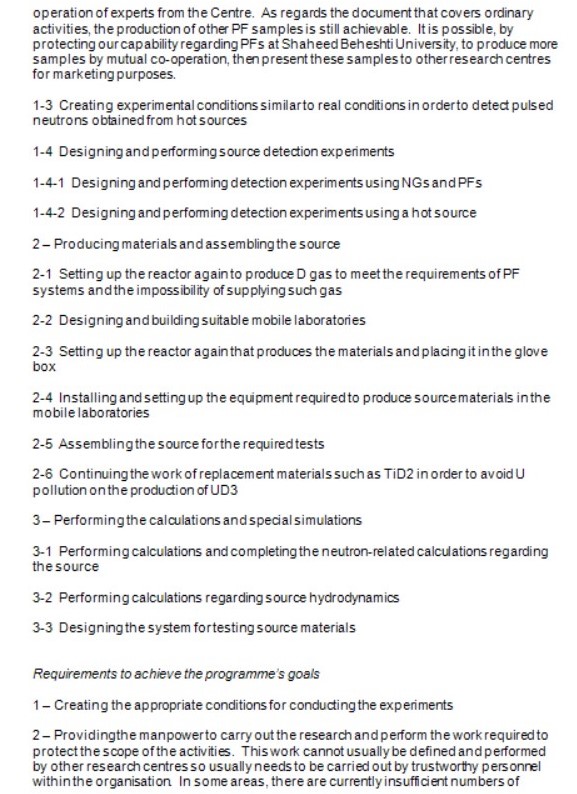
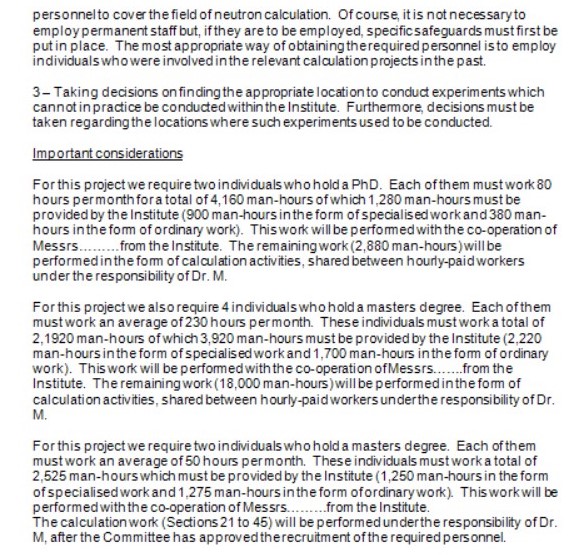
Figure 8. Translation of 2007 Iranian document, “Outlook for Special Neutron-Related Activities over the Next 4 Years.” Source: Times of London, full text available here.
Past IAEA Assessments
In general, the information in the archives confirms and adds significantly to the documentation gathered over many years by the IAEA from member states that also shows a restructuring of Iran’s nuclear weapons program, but not its end, in 2003 and 2004.
In an annex to its November 2011 safeguards report on Iran, the IAEA explained that “most of the activities carried out under the AMAD Plan were conducted during 2002 and 2003.” It detailed how the AMAD Plan came to be stopped, but its work preserved:
…Work on the AMAD Plan was stopped rather abruptly pursuant to a “halt order” instruction issued in late 2003 by senior Iranian officials. According to that information, however, staff remained in place to record and document the achievements of their respective projects. Subsequently, equipment and work places were either cleaned or disposed of so that there would be little to identify the sensitive nature of the work which had been undertaken.24
The IAEA also detailed some of what was then known about the activities and evolving structure of Iran’s nuclear weapons program at the time (Figure 9). It reported, “Mohsen Fakhrizadeh (Mahabadi) was the Executive Officer of the AMAD Plan…” Although its information at the time was only partial, under the AMAD Plan, the IAEA wrote, “three technical areas” were pursued: “the green salt project; high explosives (including the development of exploding bridgewire detonators); and re-engineering of the payload chamber of the Shahab 3 missile re-entry vehicle.”25 It continued:
The Agency (the IAEA) has other information from Member States which indicates that some activities previously carried out under the AMAD Plan were resumed later, and that Mr Fakhrizadeh retained the principal organizational role, first under a new organization known as the Section for Advanced Development Applications and Technologies (SADAT), which continued to report to MODAFL, and later, in mid-2008, as the head of the Malek Ashtar University of Technology (MUT) in Tehran…in February 2011, Mr Fakhrizadeh moved his seat of operations from MUT to an adjacent location known as the Modjeh Site, and [he] now leads the Organization of Defensive Innovation and Research [SPND]. The Agency is concerned because some of the activities undertaken after 2003 would be highly relevant to a nuclear weapon programme.
The IAEA concluded, “The information indicates that prior to the end of 2003 [the activities] took place under a structured programme. There are also indications that some activities relevant to the development of a nuclear explosive device continued after 2003, and that some may still be ongoing.”26 The information in the archives adds to the IAEA’s earlier assessment, fills in holes in that assessment, and more broadly suggests that, if anything, the IAEA has underestimated the extent of Iran’s post-2003 nuclear weapons work.
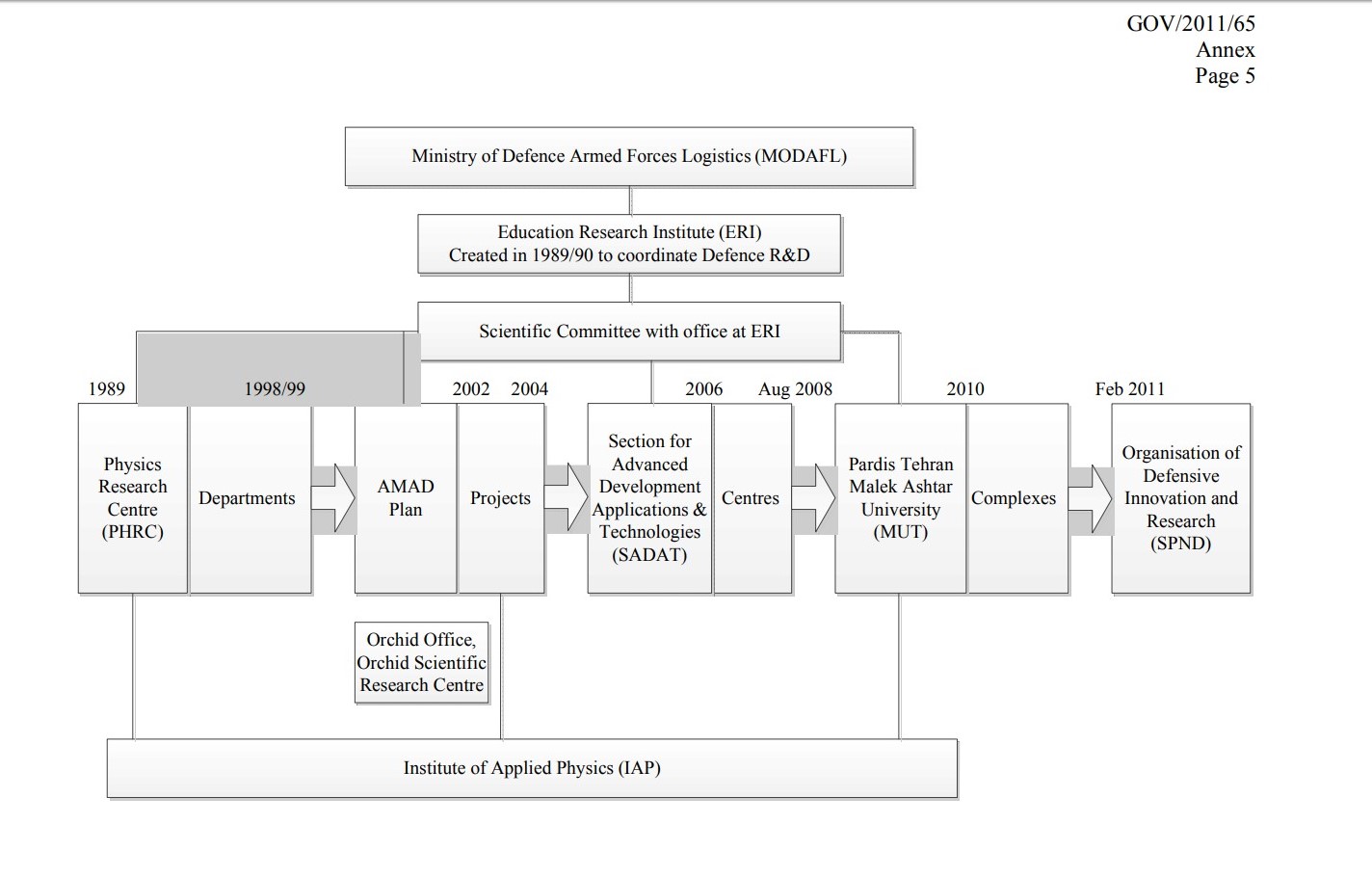
Figure 9. Evolution of organizational structure of Iran’s nuclear weapons program from 1989 to 2011. The AMAD Plan ultimately evolved into the SPND. Credit: IAEA Director General safeguards report, GOV/2011/65, Annex, page 5.
Field for Expansion of Advanced Technologies’ Deployment FEDAT/SADAT
FEDAT/SADAT was the incarnation of the AMAD Plan by 2005/2006 (Figure 9). Other documentation provided by the Times of London in 2009 to the Institute supports the IAEA’s findings about the evolution of the AMAD program to FEDAT/SADAT.27 A leaked December 2005 memorandum provided by intelligence sources, from Mr. Fakhrizadeh, addressed the heads of 12 departments of “FEDAT” or the Field for Expansion of Advanced Technologies’ Deployment, known by an alternative translation, as used by the IAEA in its November 2011 safeguards report, Section for Advanced Development Applications and Technologies, or “SADAT” (see Figure 10).28 An IAEA Board of Governors meeting in 2008 also involved discussion of other Iranian documents and another letter from Fakhrizadeh, written “to the same department heads as mentioned in the memo seen by The Times – that chastised staff for using the real names of military scientists.”29

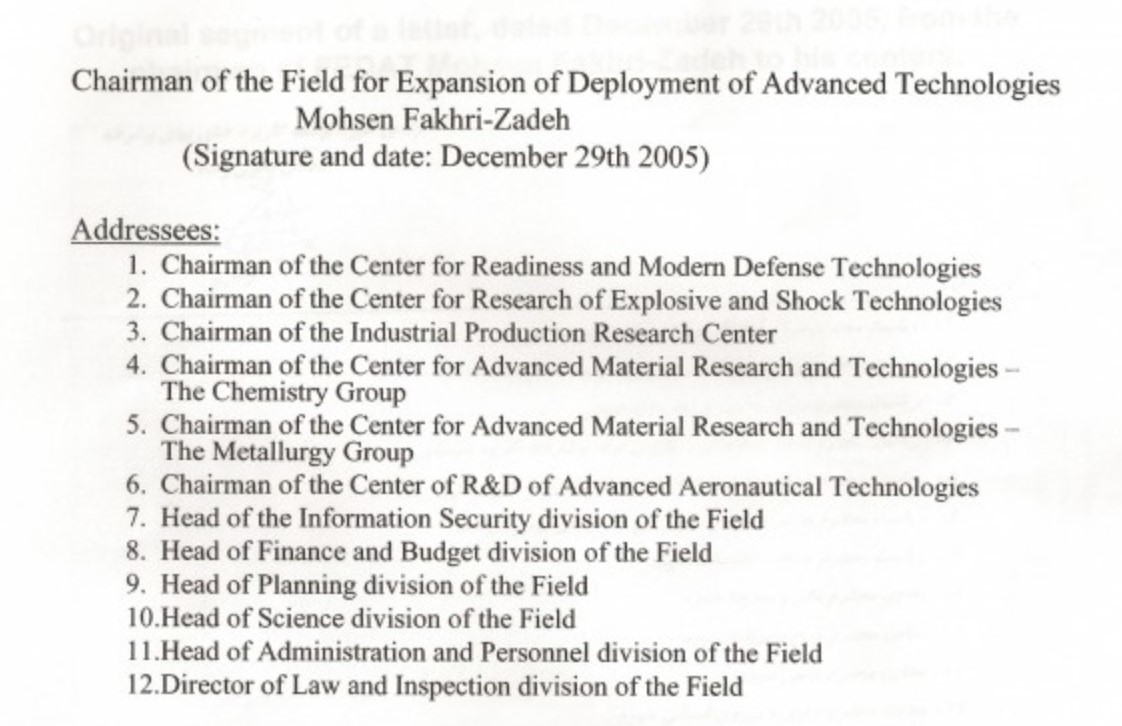
Figure 10. Farsi document written by Mohsen Fakhrizadeh, and its English translation, addressed to the 12 chairs of departments of FEDAT/SADAT. Source: Times of London, full text available here.
Latest Incarnation: Organization of Defensive Innovation and Research (SPND)
The PHRC/AMAD/FEDAT or SADAT programs eventually evolved into the SPND. The IAEA reported in its December 2015 report on Iran’s military nuclear program noted, “A new organization known as the Organization of Defensive Innovation and Research was established by Mohsen Fakhrizadeh and based at the Mojdeh Site near Malek Ashtar University in Tehran.”30
A seized Iranian document shows that, later, several key nuclear officials, several of whom are known or suspected to have been in the AMAD program, were in place as leaders in the Organization of Defensive Innovation and Research [SPND] (Figure 11). Abbasi-Davani and Fakhrizadeh are mentioned and are discussed above as major leaders of the AMAD program. Mohammad-Mehdi Hadavi, a Ministry of Defense official, appeared in discussions mentioned above about splitting of AMAD into covert and overt parts in 2003.
Akbar Motallebizadeh, also known as Ali Akbar Motallebizadeh, and listed as a SPND official in the document, was sanctioned by Australia,31 and along with Sa’eed Borji, is suspected to have links to high explosive work at Taleghan, aka Parchin. Motallebizadeh published work on nanodiamond research with Borji.32
Figure 12 is an image from the nuclear archive that shows Mohammad Mehdi Tehranchi, listed as an SPND official, at a test of a flash x-ray in Taleghan 2 at Parchin in the early 2000s. At the time, he was in charge of Project 3/30.33 He is a physicist who studied in Russia. Currently, he is acting president of Islamic Azad University and head of the Supreme Council for Science, Research, and Technology. Formerly, he was, inter alia, the head of Shahid Beheshti University.
According to dissident groups and government assessments, SPND remains active today.

Figure 11. A Farsi language document from the Iranian archive indicates the names of officials who were later in charge of various elements of the dispersed program, as it later became known by 2011 as Organization of Defensive Innovation and Research [SPND]. The figure listing the names in English comes from a slide deck provided by Israel.

Figure 12. Mohammad Mehdi Tehranchi (on left in both images), at a test of the flash x-ray (FXR) in Taleghan 2 at Parchin in the early 2000s, according to Israelis knowledgeable about the archive.
Conclusion and Recommendations
The new information in the Iranian atomic archive provides a more complete picture of the transformation of the AMAD program into successor organizations that were intended to continue to pursue nuclear weapons work in a more covert manner. As reported in the IAEA’s December 2015 “Final Assessment on Past and Present Outstanding Issues Regarding Iran’s Nuclear Programme,” the results of its investigation into the military nature of Iran’s nuclear activities carried out before the January 2016 implementation of the Iran nuclear deal, Iran “specifically denied the existence of the AMAD Plan.”34 The Iranian archive documents and other body of evidence shows that the AMAD Plan did indeed exist, and that it carried on in a more careful and dispersed fashion after 2003, eventually incarnated as SPND.
The burden is on Iran, and by virtue of its duties, the IAEA, to ensure verifiably that any remaining nuclear weapons programs – including the development or production of nuclear weapon components and development of delivery mechanisms, are ended. This will involve the IAEA using the information in the seized archives to expand inspections and monitoring in Iran and build a stronger public characterization of Iran’s past nuclear weapons work. There is a renewed urgency for the IAEA to re-examine whether Iran is maintaining and advancing a nuclear weapons program today using the newest iteration, SPND. It is vital for the inspectors to have full, unrestricted access to relevant Iranian technical and scientific personnel, equipment, and sites, including those at military facilities. Only then will the international community be able to have confidence that Iran fully complies with all its obligations under its safeguards agreement, the Additional Protocol, and the JCPOA, demonstrating that its nuclear program is peaceful. Anything short of that undermines the credibility of the international nonproliferation regime and sets a negative precedent for future proliferant states.
[1] Olli Heinonen is Former Deputy Director General of the IAEA and head of its Department of Safeguards. He is a Senior Advisor on Science and Nonproliferation at the Foundation for Defense of Democracies.
[2] Documentation seized from Tehran contains, according to Israeli statements, some 55,000 pages, and another 55,000 files on 183 CDs. Israeli officials estimated that this was about 20 percent of the material stored at the archive. See: Prime Minister Benjamin Netanyahu, Presentation, April 30, 2018.Available at: https://www.youtube.com/watch?v=qmSao-j7Xr4 ↩
[3] Some of the information is still to be fully vetted. ↩
[4] Undated Iranian plan with schedule for warhead manufacture, from the nuclear archive seized by Israel, to be discussed in a forthcoming Institute report. ↩
[5] Office of the Director of National Intelligence, National Intelligence Estimate: Iran: Nuclear Intentions and Capabilities, November 2007,Key excerpts available at: https://www.nytimes.com/2007/12/04/washington/04itext.html ↩
[6] Ibid. ↩
[7] IAEA Director General, Implementation of the NPT Safeguards Agreement in the Islamic Republic of Iran, GOV/2003/75, November 10, 2003, paragraph 13,https://www.iaea.org/sites/default/files/gov2003-75.pdf ↩
[8] IAEA Director General, Final Assessment on Past and Present Outstanding Issues Regarding Iran’s Nuclear Programme, GOV/2015/68, December 2, 2015, paragraph 87,http://isis-online.org/uploads/isis-reports/documents/IAEA_PMD_Assessment_2Dec2015.pdf ↩
[9] The Institute independently verified Israel’s translations of the Iranian documents with a professional translator. Israel provided a slide deck and other explanation documents that help explain the Iranian documents, and those slides appear in the figures throughout this report. ↩
[10] IAEA Director General, Implementation of the NPT Safeguards Agreement and relevant provisions of Security Council resolutions in the Islamic Republic of Iran, GOV/2011/65, November 8, 2011, Attachment 1,http://isis-online.org/uploads/isis-reports/documents/IAEA_Iran_8Nov2011.pdf ↩
[11] Netanyahu described during a September 2018 United Nations General Assembly speech the existence of a secret nuclear warehouse, also in Tehran, where he claimed Iran was storing equipment and materiel, and even 15 kilograms of radioactive material that it had since disposed of, all once used in its nuclear weapons program. See John Irish and Arshad Mohammed, “Netanyahu, in U.N. speech, claims secret Iranian nuclear site,” Reuters. September 27, 2018, https://www.reuters.com/article/us-un-assembly-israel-iran/netanyahu-in-un-speech-claims-secret-iranian-nuclear-site-idUSKCN1M72FZ. A video of his presentation is at: https://www.youtube.com/watch?v=s1X39WjzTVQ ↩
[12] “Re-Planning 110 According to New Instructions,” original in Farsi, see Figures 1 and 2. ↩
[13] For background on Taleghan 1 and the neutron initiator experiments, see Albright, Sarah Burkhard, Heinonen, and Frank Pabian, New Information about the Parchin Site: What the Atomic Archive Reveals About Iran’s Past Nuclear Weapons Related High Explosive Work at the Parchin High Explosive Test Site, Institute for Science and International Security, October 23, 2018,http://isis-online.org/isis-reports/detail/new-information-about-the-parchin-site ↩
[14] Ibid. ↩
[15] There is some dispute over whether this term is executor, commissioner, or commander. Commander seems to fit better with the military nature of the program. ↩
[16] “Iran’s Investigation of Possible Underground Nuclear Test Sites in the AMAD Program Prior to 2004,” Institute for Science and International Security, May 1, 2018, http://isis-online.org/isis-reports/detail/irans-investigation-of-possible-underground-nuclear-test-sites-in-the-amad/8 ↩
[17] IAEA, GOV/2011/65, November 8, 2011, p. 9 and see Figure 10 ↩ [18] IAEA Director General, Implementation of the NPT Safeguards Agreement in the Islamic Republic of Iran, GOV/2003/75, November 10, 2003, paragraph 13, https://www.iaea.org/sites/default/files/gov2003-75.pdf ↩
[19] Ibid. ↩
[20] For more on the Physics Research Center, see the Institute’s extensive work including “The Physics Research Center and Iran’s Parallel Military Nuclear Program,” by Albright, Paul Brannan, and Stricker, February 23, 2012, http://isis-online.org/uploads/isis-reports/documents/PHRC_report_23February2012.pdf and http://isis-online.org/phrc ↩
[21] IAEA, GOV/2011/65, November 8, 2011, p. 5. ↩
[22] “ISIS Imagery Brief: Destruction at Iranian Site Raises New Questions about Iran’s Nuclear Activities,” Institute for Science and International Security, June 17, 2004, http://isis-online.org/isis-reports/detail/isis-imagery-brief-destruction-at-iranian-site-raises-new-questions-about-i/8 ↩
[23] “Farsi and English Versions of Document on Neutron Initiator,” Institute for Science and International Security, December 14, 2009,http://isis-online.org/isis-reports/detail/farsi-and-english-versions-of-document-on-neutron-initiator/ ↩
[24] IAEA, GOV/2011/65, November 8, 2011, pp. 5-6. ↩
[25] IAEA, GOV/2011/65, November 8, 2011, p. 5. ↩
[26] Ibid. ↩
[27] Catherine Philip, “Leaked Memo Identifies Man at Head of Iran’s Nuclear Programme,” The London Times, December 14, 2009,http://archive.li/jyp5s ↩
[28] “Documents Assessing the Organizational Structure of FEDAT,” Institute for Science and International Security, December 14, 2009,http://isis-online.org/isis-reports/detail/documents-assessing-the-organizational-structure-of-fedat/8 ↩
[29] “Leaked Memo Identifies Man at Head of Iran’s Nuclear Programme.”↩
[30] IAEA, GOV/2015/68, December 2, 2015. ↩
[31] Craig Emerson, Australian Minister of Trade, Autonomous Sanctions (Designated Persons and Entities and Declared Persons– Iran) List 2012, Autonomous Sanctions Regulations 2011, January 25, 2012. ↩
[32] See for example, Mohamad Amin, Ali Akbar Mottalebizadeh, and Saeed Borji, “Influence of cooling medium on detonation synthesis of ultradispersed diamond,” Diamond and Related Materials, 18(4):611–614, April 2009. ↩
[33] See Albright, Burkhard, Heinonen, and Pabian, New Information about the Parchin Site, October 23, 2018.↩
[ 34] IAEA, GOV/2015/68, December 2, 2015 ↩

 twitter
twitter